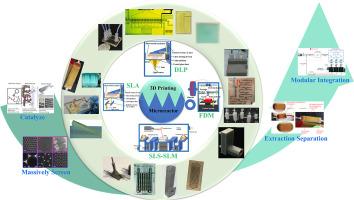3D打印制备微流体器件:技术、材料、应用与展望
IF 7.9
Q1 ENGINEERING, MULTIDISCIPLINARY
引用次数: 0
摘要
由于其卓越的质量和传热效率、精确的流体操纵和固有的安全性,微流体装置已成为化学过程强化的基石。但传统的制造工艺存在成本高、周期长、结构设计自由度不足等问题。利用逐层增材制造,3D打印提供了一种革命性的方法来制造微流体装置,其特点是亚微米分辨率,无与伦比的设计灵活性和快速原型制作能力。本文系统综述了用于化工行业的3D打印微流控装置的技术体系。从主流印刷技术(光固化、熔融挤出、粉床熔融)的形成机理和适用场景出发,对光敏树脂、热塑性线材、金属/陶瓷粉末等材料的界面特性和化学相容性进行了比较分析。重点讨论了3D打印微反应器在催化反应、纳米材料合成、连续流分离和多功能集成等化学领域的创新应用。最后,针对多材料共印、表面粗糙度控制、高通量生产等关键技术瓶颈,提出了数字孪生驱动的高通量设计-制造-测试平台的发展方向,为微流控器件的产业化应用和化工行业的低碳转型提供理论支持。本文章由计算机程序翻译,如有差异,请以英文原文为准。

Fabrication of microfluidic devices by 3D printing: technology, materials, applications and prospects
Microfluidic devices have emerged as a cornerstone of chemical process intensification, owing to their exceptional mass and heat transfer efficiencies, precise fluid manipulation, and inherent safety. However, their traditional manufacturing technology is limited by high cost, long cycle and insufficient structural design freedom. Leveraging layer-by-layer additive manufacturing, 3D printing offers a revolutionary approach to fabricating microfluidic devices, characterized by sub-micron resolution, unparalleled design flexibility, and rapid prototyping capabilities. This paper systematically reviews the technical system of 3D printing microfluidic devices for the chemical industry. Starting from the forming mechanism and applicable scenarios of mainstream printing technologies (photocuring, melt extrusion, powder bed melting), the interface characteristics and chemical compatibility of photosensitive resin, thermoplastic wire, metal/ceramic powder and other materials are compared and analyzed. The innovative applications of 3D printed microreactors in chemical scenarios such as catalytic reaction, nanomaterial synthesis, continuous flow separation and multi-functional integration are mainly discussed. Finally, aiming at the key technical bottlenecks such as multi-material co-printing, surface roughness control and high-throughput production, the development direction of high-throughput design-manufacturing-testing platform driven by digital twin is proposed, which provides theoretical support for the industrial application of microfluidic devices and the low-carbon transformation of the chemical industry.
求助全文
通过发布文献求助,成功后即可免费获取论文全文。
去求助
来源期刊

Results in Engineering
Engineering-Engineering (all)
CiteScore
5.80
自引率
34.00%
发文量
441
审稿时长
47 days
 求助内容:
求助内容: 应助结果提醒方式:
应助结果提醒方式:


